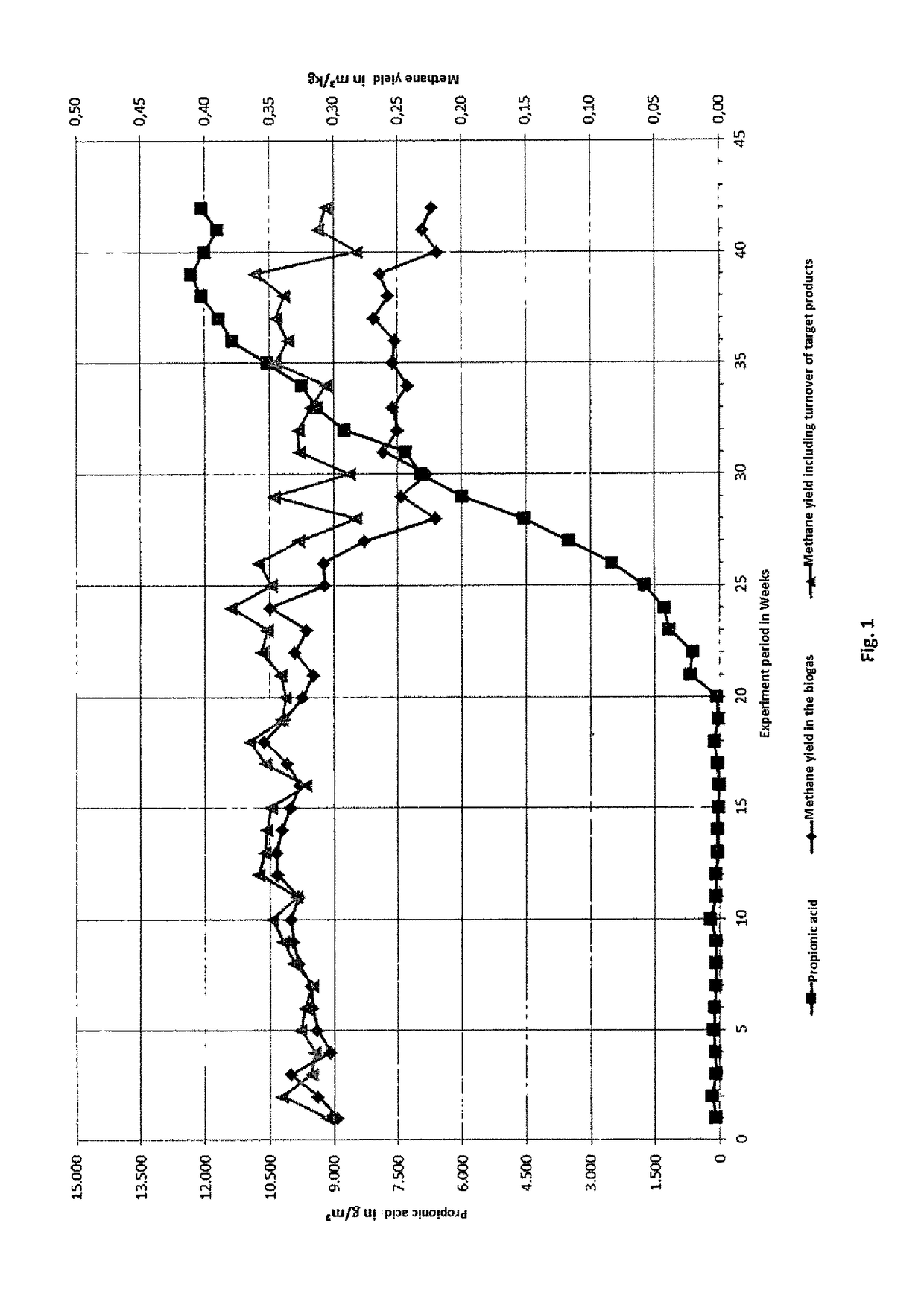Method for material use of organic substrate
a technology of organic substrate and material use, which is applied in the direction of waste based fuel, fermentation, etc., can solve the problems of reducing the yield and the problem of further use, reducing the economic use of the gas stream obtained from a pure hydrolysis and/or acidification process, and undesirable decomposition to biogas and biomethane by hydrolysis in the production of recyclable materials, etc., to achieve cost-effective, high total yield of the substrate, and cost-effective
- Summary
- Abstract
- Description
- Claims
- Application Information
AI Technical Summary
Benefits of technology
Problems solved by technology
Method used
Image
Examples
example 1
Design Example 1
[0077]One possible technical design of the method will be illustrated in the following text based on the example of obtaining propionic acid as the target product and biogas. Propionic acid can be formed via microbial decomposition paths from a wide variety of starting materials. For example, decomposition paths from glycerin, amino acids, glucose and other sugars such as pentoses and also from organic acids to propionic acid are known. Of course, other target products such as organic acids and microbiological metabolites or mixtures thereof may also be obtained according to the same principle. Essential features of this design example are also shown in FIG. 2.
[0078]Organic residues from the catering and luxury food industry such as meal leftovers and edible remains from breweries or other fermentation methods may be used as organic substrate. The use of these organic residues is financially attractive. The contents may vary depending on the origin of the residue res...
example 2
Design Example 2
[0092]A further possible technical design of the method will be illustrated in the following text based on the example of obtaining aromatic compounds such as cresol and / or skatole and methane. At the same time, these substances represent target products which are produced in the fermentation of particularly protein-rich substrates and which are mostly present in the undissociated state. Essential features of this design example are represented in FIG. 3. The following notes are formulated with only cresol as the target product for exemplary purposes.
[0093]Organic residues such as are described in Design example 1 or other organic substrates with relevant protein and / or aromatic compound content are used as organic substrate. Organic substrates particularly with significant contents of the aromatic amino acids phenylalanine, tryptophan or tyrosine, or with contents of other, similar aromatic compounds are interesting for such a process, because possible intermediary ...
example 3
Design Example 3
[0105]A further possible technical design of the method will be illustrated in the following text based on the example of obtaining isovaleric acid and methane. This method may also be used for recovering other organic acids, particularly short-chain or aromatic carboxylic acids such as isobutyric acid, butyric acid, valeric acid, caproic acid and / or benzoic acid or corresponding mixtures. A characteristic quality for these target product is their accumulation in dissociated form in the fermentation medium. Essential features of this design example are shown in FIG. 4.
[0106]Organic residues such as are described in Design example 1 or other organic substrates with relevant organic compound content based on at least C5- and / or C6-structures are used as organic substrate. These may particularly be proteins and / or amino acids as well as carbohydrates such as pentosans. Such compounds may be decomposed anaerobically by means of the metabolite isovaleric acid. Through par...
PUM
| Property | Measurement | Unit |
|---|---|---|
| concentration | aaaaa | aaaaa |
| concentration | aaaaa | aaaaa |
| concentration | aaaaa | aaaaa |
Abstract
Description
Claims
Application Information
 Login to View More
Login to View More - R&D
- Intellectual Property
- Life Sciences
- Materials
- Tech Scout
- Unparalleled Data Quality
- Higher Quality Content
- 60% Fewer Hallucinations
Browse by: Latest US Patents, China's latest patents, Technical Efficacy Thesaurus, Application Domain, Technology Topic, Popular Technical Reports.
© 2025 PatSnap. All rights reserved.Legal|Privacy policy|Modern Slavery Act Transparency Statement|Sitemap|About US| Contact US: help@patsnap.com

